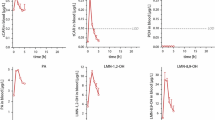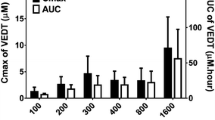Abstract
d-Limonene has efficacy in preclinical models of breast cancer, causing >80% of carcinomas to regress with little host toxicity. We performed a pilot study on healthy human volunteers to identify plasma metabolites of limonene and to assess the toxicity of supradietary quantities ofd-limonene. Seven subjects ingested 100 mg/kg limonene in a custard. Blood was drawn at 0 and 24 h for chemistry-panel analysis and at 0, 4, and 24 h for limonenemetabolite analysis. On-line capillary gas chromatography/mass spectrometry (GC/MS) analysis indicated that at least five compounds were present at 4 h that were not present at time zero. Two major peaks were identified as the rat limonene metabolites dihydroperillic acid and perillic acid, and two minor peaks were found to be the respective methyl esters of these acids. A third major peak was identified as limonene-1,2-diol. Limonene was a minor component. At a dose of 100 mg/kg, limonene caused no gradable toxicity. Limonene is metabolized by humans and rats in a similar manner. These observations and the high therapeutic ratio of limonene in the chemotherapy of rodent cancers suggest that limonene may be an efficacious chemotherapeutic agent for human malignancies.
Similar content being viewed by others
References
Crowell PL, Gould MN (1994) Chemoprevention and therapy of cancer byd-limonene. Crit Rev Oncogenesis 5: 1
Crowell PL, Chang RR, Ren Z, Elson CE, Gould MN (1991) Selective inhibition of isoprenylation of 21–26 kDa proteins by the anticarcinogend-limonene and its metabolites. J Biol Chem 266: 17679
Crowell PL, Lin S, Vedejs E, Gould MN (1992) Identification of circulating metabolites of the antitumor agentd-limonene capable of inhibiting protein isoprenylation and cell growth. Cancer Chemother Pharmacol 31: 205
Crowell PL, Kennan WS, Haag JD, Ahmad S, Vedejs E, Gould MN (1992) Chemoprevention of mammary carcinogenesis by hydroxylated derivatives ofd-limonene. Carcinogenesis 13: 1261
Crowell PL, Ren Z, Lin S, Vedejs E, Gould MN (1994) Structure-activity relationships among monoterpene inhibitors of protein isoprenylation and cell proliferation. Biochem Pharmacol 47: 2405
Dietrich DR, Swenberg JA (1991) The presence of α2u-globulin is necessary ford-limonene promotion of male rat kidney tumors. Cancer Res 51: 3512
Elegbede JA, Elson CE, Qureshi A, Tanner MA, Gould MN (1984) Inhibition of DMBA-induced mammary cancer by the monoterpened-limonene. Carcinogenesis 5: 661
Elegbede JA, Elson CE, Tanner MA, Qureshi A, Gould MN (1986) Regression of rat primary mammary tumors following dietaryd-limonene. J Natl Cancer Inst 76: 323
Elegbede JA, Maltzman TH, Verma AK, Tanner MA, Gould MN (1986) Mouse skin tumor promoting activity of orange peel oil andd-limonene: a reevaluation. Carcinogenesis 7: 2047
Elegbede JA, Maltzman TH, Elson CE, Gould MN (1993) Effects of anticarcinogenic monoterpenes on phase II hepatic metabolizing enzymes. Carcinogenesis 14: 1221
Elson CE, Maltzman TH, Boston JL, Tanner MA, Gould MN (1988) Anti-carcinogenic activity ofd-limonene during the initiation and promotion-progression stages of DMBA-induced rat mammary carcinogenesis. Carcinogenesis 9: 331
Haag JD, Lindstrom MJ, Gould MN (1992) Limonene-induced regression of mammary carcinomas. Cancer Res 52: 4021
Harris CC (1989) Interindividual variation among humans in carcinogen metabolism, DNA adduct formation and DNA repair. Carcinogenesis 10: 1563
Igimi H, Nishimura M, Kodama R, Ide H (1974) Studies on the metabolism ofd-limonene (p-metha-1,8-diene). I. The absorption, distribution and excretion ofd-limonene in rats. Xenobiotica 4: 77
Igimi H, Tamura R, Toraishi K, Tamamoto F (1991) Medical dissolution of gallstones. Clinical experience ofd-limonene as a simple, safe, and effective solvent. Dig Dis Sci 36: 200
Jirtle RL, Haag JD, Ariazi E, Gould MN (1993) Increased mannose 6-phosphate/insulin-like growth factor II receptor and transforming growth factor β1 levels during monoterpene-induced regression of mammary tumors. Cancer Res 53: 3849
Kato K, Cox AD, Hisaka MM, Graham SM, Buss JE, Der CJ (1992) Isoprenoid addition to Ras protein is the critical modification for its membrane association and transforming activity. Proc Natl Acad Sci USA 89: 6403
Kodama R, Yano T, Furukawa K, Noda K, Ide H (1976) Studies on the metabolism ofd-limonene (p-mentha-1,8-diene). IV. Isolation and characterization of new metabolites and species differences in metabolism. Xenobiotica 6: 377
Maltzman TH, Hurt LM, Elson CE, Tanner MA, Gould MN (1989) The prevention of nitrosomethylurea-induced mammary tumors byd-limonene and orange oil. Carcinogenesis 10: 781
Maltzman TH, Christou M, Gould MN, Jefcoate CR (1991) Effects of monoterpenoids on in vivo DMBA-DNA adduct formation and on phase I hepatic metabolizing enzymes. Carcinogenesis 12: 2081
McNamee D (1993) Limonene trial in cancer. Lancet 342: 801
Nazar-Stewart V, Motulsky AG, Eaton DL, White E, Hornung SK, Leng ZT, Stapleton P, Weiss NS (1993) The glutathioneS-transferase μ polymorphism as a marker for susceptibility to lung carcinoma. Cancer Res 53: 2313
Shields PG, Bowman ED, Harrington AM, Doan VT, Weston A (1993) Polycyclic aromatic hydrocarbon-DNA adducts in human lung and cancer susceptibility genes. Cancer Res 53: 3486
Sparnins VL, Venegas PL, Wattenberg LW (1982) Glutathione-Stransferase activity: enhancement by compounds inhibiting chemical carcinogenesis and by dietary constituents. J Natl Cancer Inst 68: 493
Wattenberg LW (1983) Inhibition of neoplasia by minor dietary constituents. Cancer Res 43: 2448
Wattenberg LW, Coccia JB (1991) Inhibition of 4-(methylnitrosoamino)-1-(3-pyridyl)-1-butanone carcinogenesis in mice byd-limonene and citrus fruit oils. Carcinogenesis 12: 115
Wattenberg LW, Sparnins VL, Barany G (1989) Inhibition ofN-nitrosodiethylamine carcinogenesis in mice by naturally occurring organosulfur compounds and monoterpenes. Cancer Res 49: 2689
Author information
Authors and Affiliations
Rights and permissions
About this article
Cite this article
Crowell, P.L., Elson, C.E., Bailey, H.H. et al. Human metabolism of the experimental cancer therapeutic agentd-limonene. Cancer Chemother. Pharmacol. 35, 31–37 (1994). https://doi.org/10.1007/BF00686281
Received:
Accepted:
Issue Date:
DOI: https://doi.org/10.1007/BF00686281




